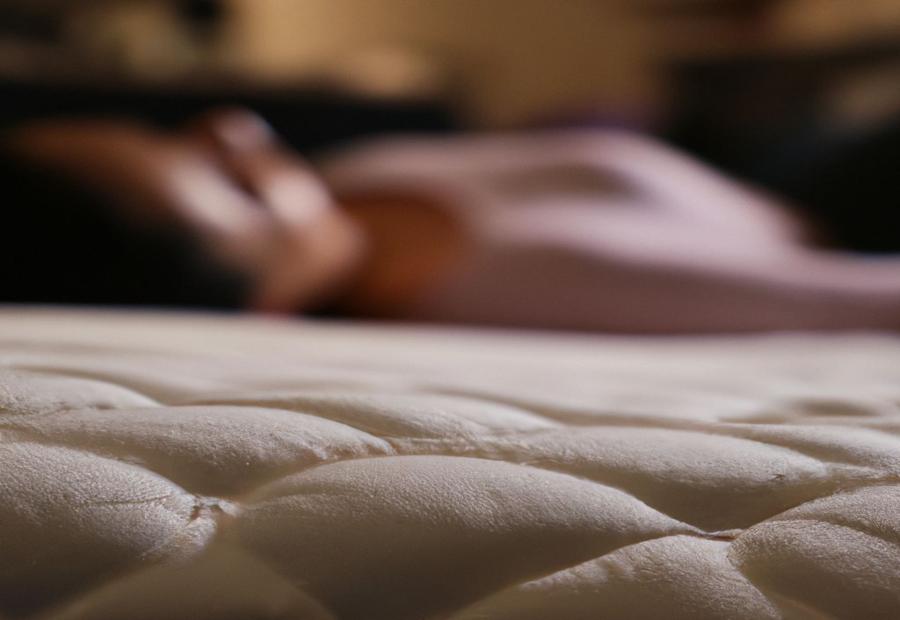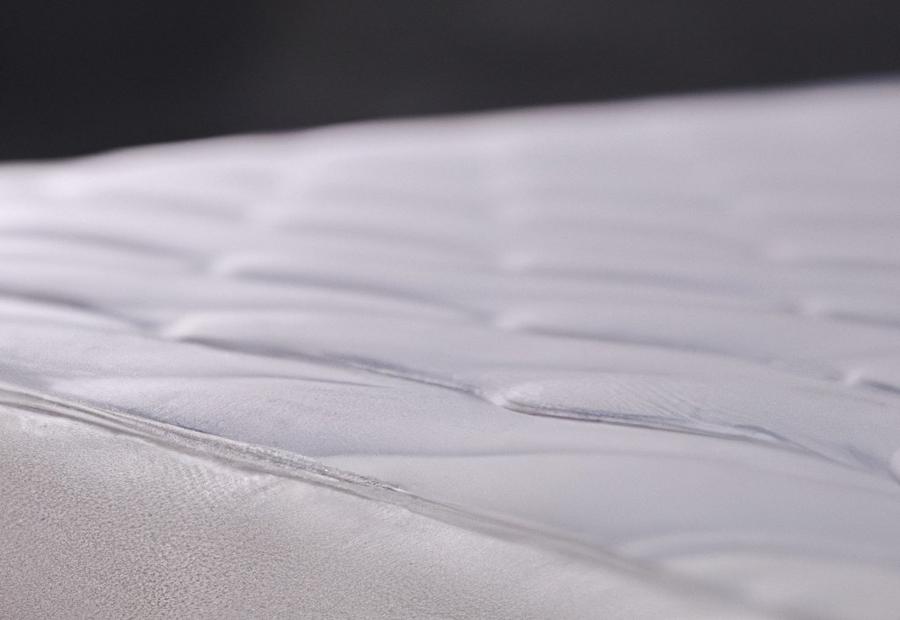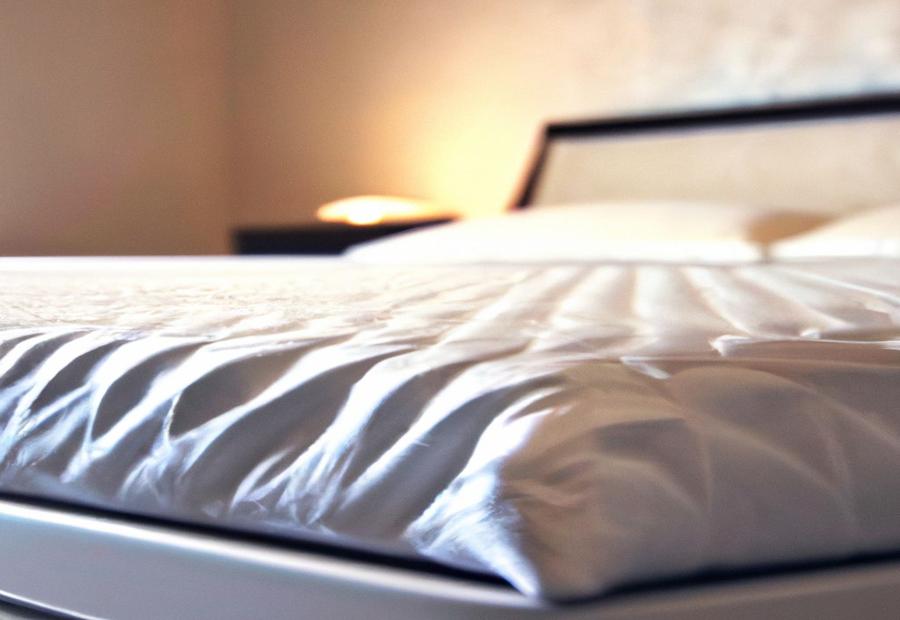Key Takeaways:
- Assessing the firmness of your mattress is important for ensuring sleep quality and comfort. Look out for signs such as waking up with body aches or feeling restless during the night, which may indicate that your mattress is too firm.
- To soften a firm mattress, check the mattress base for proper support, consider adding a mattress pad or topper for extra cushioning, adjust the temperature in the bedroom for optimal comfort, break in the mattress over time, and rotate or flip the mattress to evenly distribute wear.
- If you’re experiencing discomfort on a firm mattress despite trying to soften it, it may be time to consider replacing the mattress. Factors to consider include the age of the mattress, the presence of visible wear and tear, and the level of support it provides.

Photo Credits: Www.Mattressreviewguru.Com by Andrew Ramirez
When it comes to getting a good night’s sleep, mattress firmness plays a vital role. In this section, we will explore the significance of mattress firmness for sleep quality. From finding the perfect balance between softness and support to its impact on spinal alignment, we’ll uncover the factors that make mattress firmness a key consideration for a restful slumber. So, let’s dive in and discover how your mattress firmness can significantly impact the quality of your sleep.
Explanation of the importance of mattress firmness for sleep quality
Mattress firmness is critical to guarantee a good night’s sleep. It has a direct bearing on the comfort and support our bodies get when we rest. Achieving the perfect firmness is vital for keeping correct spinal alignment, relieving pressure points, and minimizing any pain or discomfort that can stop you from sleeping. If a mattress is too firm, it can lead to issues such as too much pressure on certain parts of the body, not contouring correctly, and making it hard to find a cosy sleeping position.
The influence of mattress firmness on sleep comfort and quality should not be ignored. If a mattress is too firm, it can cause stiffness, discomfort, and muscle tension, resulting in restless nights and bad sleep quality. Without sufficient cushioning and give, natural movement during sleep can be limited, leading to reduced blood flow and more tossing and turning through the night. This can affect the general sleep experience, leaving one feeling tired and unrested in the morning.
While some people may prefer a firmer mattress due to particular needs or medical conditions, it is important to recognize when it is necessary to make a mattress softer for individual comfort. There are solutions available to ease excessive firmness. Examples include checking the base for proper support, using a mattress pad or topper for extra cushioning, changing the bedroom temperature for optimal comfort, allowing the mattress to break in over time for improved comfort, or rotating/flipping the mattress to make sure wear is distributed evenly.
Let’s look at John’s story. He recently bought a new high-density foam mattress due to its advertised advantages for back support. But, he shortly realised it was too firm for his liking. Despite trying different sleeping postures and adjusting pillows, he kept experiencing discomfort throughout the night. So, he chose to follow online advice on how to make his mattress softer. He chose a plush memory foam topper, which worked effectively. With this addition, John was able to get the desired level of comfort and support, improving his sleep quality and overall well-being.
So, if you realise your mattress feels as firm as a concrete slab or a bit too comfy, it may be time to assess its firmness and explore options to guarantee a good night’s sleep.
Assessing the Firmness of Your Mattress

Photo Credits: Www.Mattressreviewguru.Com by Terry Sanchez
Assessing the firmness of your mattress is crucial for optimizing sleep quality and comfort. We’ll explore signs that indicate a mattress may be too firm and the impact it can have on your overall sleep experience. Understanding these factors will help you determine if your mattress is providing the right level of support and help improve the quality of your rest.
Signs to look out for that indicate a mattress may be too firm
A mattress’s firmness can significantly affect your sleep. It is important to be aware of signs that could suggest your mattress is too firm. This can lead to discomfort and poor sleep.
Here are five indicators of a mattress being too firm:
- Body aches and pains. Waking with extra soreness, or increased pain in areas like the hips or shoulders, could mean your mattress isn’t providing enough pressure relief.
- Lack of support. Sinking too far in, or feeling like you’re sleeping on a hard surface without enough support, suggests it may be too firm.
- Numbness and tingling in limbs. Experiencing this during or after sleep could mean the mattress is applying too much pressure.
- Restless sleeping. Tossing and turning throughout the night, or difficulty finding a comfortable position, suggests not enough comfort or cushioning.
- Disrupted sleep. Waking up during the night, or difficulty staying asleep, could mean the mattress’s firmness is affecting sleep quality.
These signs vary depending on individual needs, body types, or existing medical conditions. Pay attention to how your body feels during and after sleep to determine if your mattress may be too firm. Taking into account these signs can help you decide if your mattress is too firm.
The impact of a too-firm mattress on sleep quality and comfort
A too-firm mattress can have a huge effect on sleep quality and comfort. It can cause pain in pressure points, leading to restless nights and broken sleep. On top of this, it won’t contour to the body’s curves, resulting in poor spinal alignment. This can bring potential issues with back and neck health. Hence, it is essential to tackle any firmness issues for optimal sleep.
Sleeping on a too-firm mattress can cause various problems. It can give excessive pressure on the hips, shoulders and lower back. This can cause pain, numbness or tingling. Furthermore, it can limit movement, restricting blood circulation which can worsen discomfort.
When wondering how firm is Purple Mattress, it’s important to consider these factors. Sleeping on a mattress that is too firm can have negative effects on your body. It’s crucial to find a mattress that provides the right level of support and comfort for you. To learn more about how firm Purple Mattress is, visit this link.
Also, an overly firm mattress can alter the spine’s alignment. This can cause bad posture during sleep and long-term back pain. To prevent this, adjust the firmness of the mattress or consider replacing it.
Bed comfort is connected to mattress firmness. It is important to find the right balance between softness and support. Mattresses that are too firm don’t suit individual needs and body types. Therefore, know the signs that the mattress is too firm and take action, for example, adding a toddler mattress pad or changing the bedroom temperature. This will enhance sleep experience and keep health in check.
Softening a firm mattress requires the perfect balance between comfort and support – like adding a Netflix marathon to a Rubik’s cube competition!
Solutions for Softening a Firm Mattress

Photo Credits: Www.Mattressreviewguru.Com by Terry Walker
Looking to make your firm mattress more comfortable? Here are some solutions that can help. Check the mattress base for proper support, add a mattress pad or topper for extra cushioning, adjust the bedroom temperature for optimal comfort, and consider breaking in the mattress over time. Another option is to rotate or flip the mattress to evenly distribute wear. These tips will ensure a more cozy and relaxing sleep experience.
Checking the mattress base for proper support
- Regularly check the mattress base for proper support.
- Check the bed frame or foundation for any signs of wear or damage.
- Pay attention to the center support system, especially if the mattress is large.
- Ensure that a box spring or foundation is in good condition and providing adequate support.
- Consider using a solid platform bed instead of a traditional box spring for more consistent and sturdy support.
- Place the mattress away from heating vents and windows.
- Add a high-quality mattress pad or topper for extra cushioning and protection.
By taking these steps, you can ensure optimal comfort and extend the life of your mattress.
Adding a mattress pad or topper to provide extra cushioning
A mattress pad or topper can help make a firm mattress more comfortable. This extra layer creates a softer surface, relieving pressure points and improving sleep quality. It’s cost-effective compared to buying a new mattress. You can customize the level of softness and support by choosing different materials and thicknesses.
Cleaning and maintaining the pad/topper regularly will help it last longer. People who have added one to their firm mattress often report feeling more refreshed and well-rested. It also improves spinal alignment, reducing discomfort or pain when waking up.
For even better sleep, make your bedroom a hotbed of comfort by adjusting the temperature to the perfect spot.
Adjusting the temperature in the bedroom for optimal comfort
Adjusting the temperature in the bedroom is essential for a good night’s sleep. Set the thermostat to a comfortable temperature and avoid extremes. For hot nights, use a fan or air conditioning. Choose breathable bedding materials and invest in blackout curtains to keep the room cool. Open windows and use a ceiling fan to circulate fresh air.
These adjustments will help create a comfortable sleeping environment. Experiment to find the perfect temperature for you. The optimal temperature has long-term benefits for your health. Excessive heat or cold can lead to restless sleep and stress.
Pro Tip: Invest in a smart thermostat to program and regulate the temperature. Break in your mattress like you would your new shoes for maximum comfort.
Breaking in the mattress to allow it to become more comfortable over time
Breaking in a mattress is a must for comfort over time. It allows the materials to adjust to your body shape, giving better support and reducing discomfort. Here’s a 5-step guide to break it in:
- Sleep on it regularly.
- Change sleeping positions.
- Provide good airflow.
- Avoid excessive bending or folding.
- Be patient – this takes time!
Plus, rotating or flipping the mattress every few months also helps spread wear evenly. If breaking in doesn’t yield satisfactory results, adding a mattress pad or topper will further increase comfort. Enjoy a more restful sleep experience!
Rotating or flipping the mattress to evenly distribute wear
Rotating or Flipping a Mattress to Evenly Distribute Wear: A 3-Step Guide.
- Step 1: Check if your mattress is flippable.
- – Read manufacturer instructions or tags on mattress to see if flipping is allowed.
- Step 2: Rotate or flip the mattress.
- – If you can flip it, rotate 180 degrees so the head of bed becomes the foot and vice versa.
- – If you can’t flip it, rotate 90 degrees and keep head of bed in place with one side becoming the top.
- – If specific instructions are given, follow them.
- Step 3: Create a regular schedule.
- – Rotate or flip your mattress every 3-6 months to evenly distribute wear.
- – Use calendar apps or sticky notes to remember when you last rotated or flipped.
It’s important to note that memory foam mattresses should not be flipped, but can benefit from occasional rotation. Always check manufacturer instructions or consult a sleep specialist for more information about whether your mattress should be rotated or flipped.
Regular rotation or flipping of mattresses is an effective way to even out wear and extend its lifespan, but other factors like age, comfort level, and deterioration should also be taken into account. If your mattress is old, sagging, uncomfortable, or no longer meets your sleep needs, it may be time to get a new one.
When to Consider Replacing the Mattress

Photo Credits: Www.Mattressreviewguru.Com by Albert Taylor
When it comes to knowing when it’s time to replace your mattress, there are certain signs you should look out for. In this section, we will discuss the indications that suggest your mattress may need to be replaced, as well as the factors you should consider when determining if a new mattress is necessary. By recognizing these cues and considering the relevant factors, you can make an informed decision about when to bid farewell to your old mattress and welcome a better night’s sleep.
Signs that indicate a mattress may need to be replaced
Mattresses require replacing when certain signs appear. This affects your sleep quality and comfort. Here are some clues that your mattress needs to be changed:
- Indents and sagging, especially where you sleep.
- Pain and stiffness when waking up.
- Allergies when sleeping on the mattress.
- Wear and tear before 7-10 years.
- Tossing and turning throughout the night.
These are just general signs – personal preferences and health can also influence it. If you feel discomfort or that your mattress is not working, consider changing it. Doing so will improve sleep and wellbeing.
Factors to consider when determining if a new mattress is necessary
Evaluating if a new mattress is necessary? Consider these factors:
- Signs such as sagging, wear & tear, or lumps could mean it’s time for a change.
- Mattresses usually last 7-10 years, but usage & quality can vary.
- Plus, personal preferences & physical needs can change over time.
Before purchasing a new one, consider alternative solutions. Adding a mattress pad or topper can provide extra cushioning & support. Also, adjust the temperature in your bedroom to help alleviate discomfort.
Finding the Right Mattress Firmness for You

Photo Credits: Www.Mattressreviewguru.Com by Elijah Robinson
Finding the perfect mattress firmness level can greatly impact the quality of your sleep. In this section, we will uncover the factors to consider when selecting a mattress firmness level and provide helpful tips to determine the appropriate firmness for your specific needs. With expert insights and practical advice, you’ll be able to make an informed decision that will lead to a good night’s rest. Say goodbye to restless nights and hello to a comfortable, supportive mattress. Sleep is about to get a whole lot better.
Factors to consider when selecting a mattress firmness level
Selecting the right mattress firmness is a matter of personal preference. It depends on factors such as body weight, sleeping position, health conditions, and sleeping partner.
Heavier individuals require a firmer mattress to provide support. But, lighter people may prefer a softer one. Side sleepers need medium-soft to medium-firm mattresses to relieve pressure points. Back and stomach sleepers, however, need firmer ones for spinal alignment.
Personal preference is also crucial. Some people want a plush, sinking-in feel, others like a firmer feel. People with arthritis or back pain may find 3 simple ways to make their mattress softer—a guide offers better relief and support.
If you have a sleeping partner, their preferences must be taken into account. Look for a compromise that caters to both of you.
Many mattress brands offer trial periods and return policies. This gives you a chance to test and exchange the mattress. Online resources and mattress experts can provide reviews that help you make an informed decision.
Finding the right mattress firmness is like finding your favorite pizza toppings – it’s all about personal preference.
Tips for determining the appropriate firmness level for your specific needs
Discovering the ideal firmness level for you is key to a great sleep. Here are some tips to help you find the best mattress that suits your needs and offers optimal comfort and support:
- Sleeping position: If you sleep on your back, go for a medium-firm to firm mattress; this helps keep your spine in shape. Side sleepers would enjoy a medium to medium-soft mattress as it eases pressure points. Stomach sleepers, on the other hand, would benefit from a firmer mattress to prevent sinking of the hips.
- Weight: Heavier people need a firmer mattress to avoid sagging. But, lighter people may be more comfortable on a softer mattress that hugs their body.
- Medical conditions/pain points: Suffering from chronic back pain? Pick a mattress that provides support and alleviates pressure.
- Personal preference: It’s all about your comfort, so experiment with different firmness levels until you find the perfect one.
- Try before you buy: Many mattress manufacturers provide trial periods, so take advantage of them!
- Seek advice: Get insight from healthcare providers or sleep experts when choosing the ideal firmness level.
Finding the right balance between comfort and support is crucial. Too hard, and your bed will be like a pile of bricks. Too soft, and you’ll sink into a marshmallow abyss!
Conclusion

Photo Credits: Www.Mattressreviewguru.Com by Philip Sanchez
Recapping the importance of mattress firmness and the solutions discussed, let’s conclude with an encouraging call to action for those experiencing discomfort on a firm mattress.
Recap of the importance of mattress firmness and the solutions discussed
Mattress firmness is important for quality sleep and comfort. Check for signs that your mattress may be too firm. Too-firm mattresses can cause discomfort and even pain. There are ways to soften a firm mattress:
- Check the base for support.
- Add a mattress pad or topper for cushioning.
- Adjust the bedroom temp for comfort.
- Break in the mattress over time and rotate or flip it to spread wear.
- If these don’t help, you may need to replace it. Consider the age, wear, and your comfort when deciding.
When choosing a new mattress, consider body type, sleeping position, and preference for the right firmness. Quality sleep and comfort depend on mattress firmness. If your mattress is too firm, solutions exist. Otherwise, replace it. Think about the age, condition, and your personal needs to choose.
Encouragement to take action if experiencing discomfort on a firm mattress
If you’re feeling discomfort on a firm mattress, take steps to improve your sleep quality. It can lead to pain, stiffness and restless nights.
- Check the mattress base for support. It may be contributing to the firmness.
- Add a mattress pad or topper for extra cushioning. Try gel-infused memory foam or latex.
- Cool the bedroom to make it more comfortable.
- Let the mattress settle and conform to your body shape. This takes weeks or months.
- Rotate or flip the mattress regularly. This helps keep it comfortable and prolongs its life.
- If none of this helps, replace the mattress. Look for sagging, visible wear and tear, lack of support, or excessive discomfort.
When selecting a new mattress, consider your weight, sleeping position, and firmness preferences. Test models and consult a sleep expert.
Some Facts About How to Tell if My Mattress is Too Firm:
- ✅ Symptoms of having a mattress that’s too firm include excess strain on pressure points, muscle, neck, or back pain, and poor quality sleep. (Source: Team Research)
- ✅ To soften up a firm mattress, you can check your mattress base, add a mattress pad or topper, adjust the temperature, break it in, or rotate or flip the mattress. (Source: Team Research)
- ✅ If none of these solutions work, it may be time to replace the mattress, especially if it’s nearing the end of its lifespan or showing signs of wear. (Source: Team Research)
- ✅ Layla Sleep offers mattresses with flippable firmness, allowing you to choose between a soft and firm side. (Source: Team Research)
- ✅ Firm mattresses are better for those with back pain, while soft mattresses are recommended for those with pressure point issues. (Source: Team Research)
FAQs about How To Tell If My Mattress Is Too Firm
How can I tell if my mattress is too firm?
To determine if your mattress is too firm, pay attention to symptoms such as excess strain on pressure points, muscle, neck, or back pain, and poor quality sleep. You can also check for signs like waking up with back, hip, shoulder, or neck pain or feeling tired upon waking up.
What can I do to soften up a firm mattress?
If you have a firm mattress that you want to soften, there are a few options. You can check your mattress base, add a mattress pad or topper, adjust the temperature, break it in, or rotate or flip the mattress. However, if none of these solutions work, it may be time to replace the mattress.
What are the benefits of firm and soft mattresses?
Firm mattresses are generally better for those with back pain as they provide more support and maintain proper spine alignment. On the other hand, soft mattresses are recommended for those with pressure point issues as they contour to the body and relieve pressure on the shoulders and hips.
What factors should I consider when choosing a mattress?
When choosing a mattress, consider your preferences, age, lifestyle, and sleeping habits. Additionally, the right mattress depends on your partner’s preferences if you share a bed. Factors such as body weight, sleeping position, and spinal alignment also play a role in mattress selection.
What role does mattress quality play in sleep comfort?
The quality of your mattress impacts your sleep comfort and overall health. A high-quality memory foam or hybrid mattress, such as the Layla Hybrid Mattress with memory foam technology and individually wrapped spring coils, can provide better support, alleviate pressure points, and promote better sleep quality.
When should I consider replacing my mattress?
If your mattress is nearing the end of its lifespan, showing signs of wear, or causing persistent discomfort and sleep issues, it may be time to replace it. Structural damage, broken springs, and restless movements are indicators that your mattress needs to be replaced for a better sleep experience.






